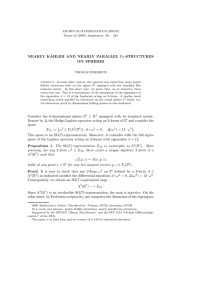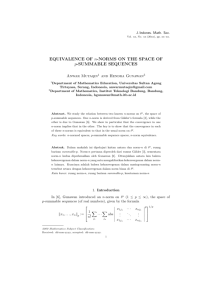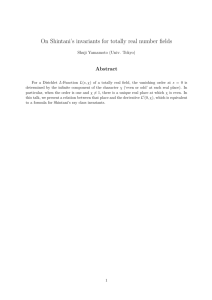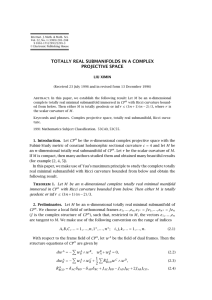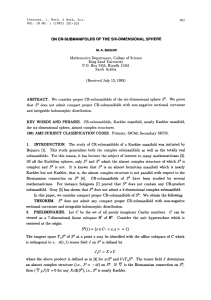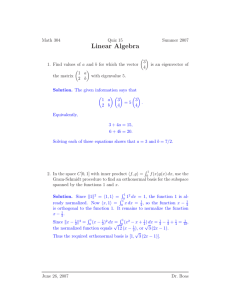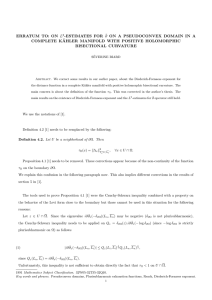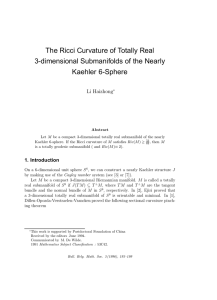Beitr¨ age zur Algebra und Geometrie Contributions to Algebra and Geometry
advertisement
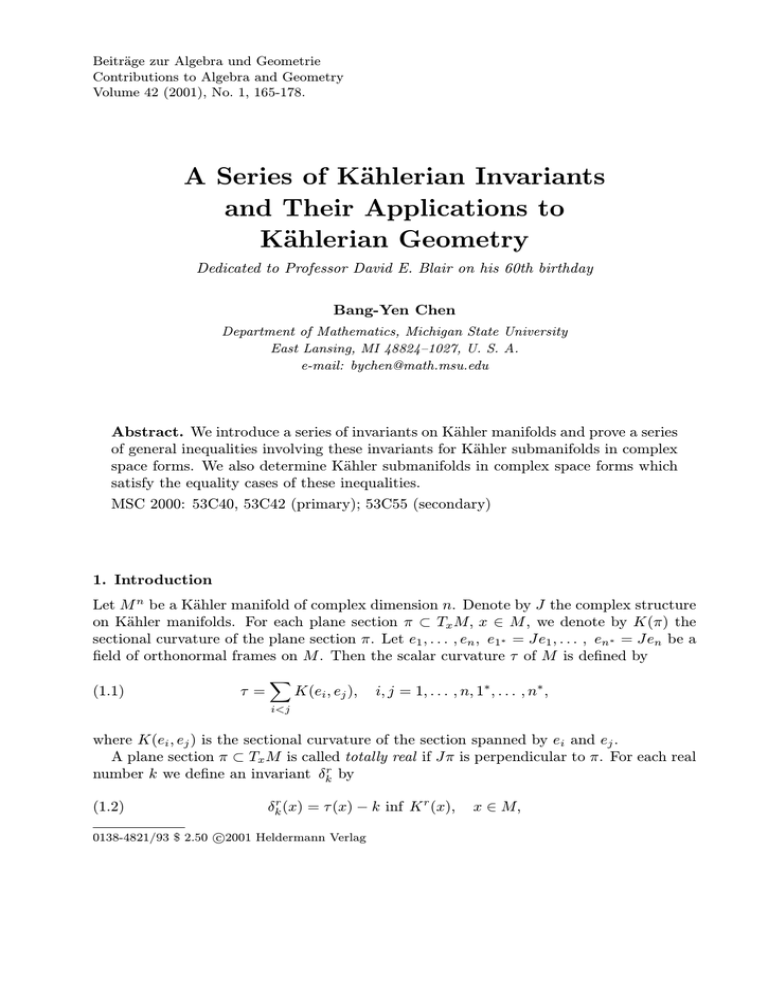
Beiträge zur Algebra und Geometrie
Contributions to Algebra and Geometry
Volume 42 (2001), No. 1, 165-178.
A Series of Kählerian Invariants
and Their Applications to
Kählerian Geometry
Dedicated to Professor David E. Blair on his 60th birthday
Bang-Yen Chen
Department of Mathematics, Michigan State University
East Lansing, MI 48824–1027, U. S. A.
e-mail: bychen@math.msu.edu
Abstract. We introduce a series of invariants on Kähler manifolds and prove a series
of general inequalities involving these invariants for Kähler submanifolds in complex
space forms. We also determine Kähler submanifolds in complex space forms which
satisfy the equality cases of these inequalities.
MSC 2000: 53C40, 53C42 (primary); 53C55 (secondary)
1. Introduction
Let M n be a Kähler manifold of complex dimension n. Denote by J the complex structure
on Kähler manifolds. For each plane section π ⊂ Tx M, x ∈ M , we denote by K(π) the
sectional curvature of the plane section π. Let e1 , . . . , en , e1∗ = Je1 , . . . , en∗ = Jen be a
field of orthonormal frames on M . Then the scalar curvature τ of M is defined by
X
(1.1)
τ=
K(ei , ej ),
i, j = 1, . . . , n, 1∗ , . . . , n∗ ,
i<j
where K(ei , ej ) is the sectional curvature of the section spanned by ei and ej .
A plane section π ⊂ Tx M is called totally real if Jπ is perpendicular to π. For each real
number k we define an invariant δkr by
(1.2)
δkr (x) = τ (x) − k inf K r (x),
c
0138-4821/93 $ 2.50 2001
Heldermann Verlag
x ∈ M,
166
Bang-Yen Chen: A Series of Kählerian Invariants. . .
where inf K r (x) = inf πr {K(π r )} and π r runs over all totally real plane sections in Tx M .
(This type of invariants is similar to the invariants introduced in [3,4,5]. For some recent
results involving this type of invariants, see for instance [6,8,9,12]).
A Kähler manifold M̃ m (4c) of constant holomorphic sectional curvature 4c is called a
complex space form. There are three types of complex space forms: elliptic, hyperbolic, or
flat according as the holomorphic sectional curvature is positive, negative, or zero.
Let CP m (4c) be a complex projective m-space endowed with the Fubini-Study metric
of constant holomorphic sectional curvature 4c. Then CP m (4c) is a complete and simplyconnected elliptic complex space form.
Complex Euclidean space Cm endowed with the usual Hermitian metric is a complete
and simply-connected flat complex space form.
Let Dm be the open unit ball in Cm endowed with the natural complex structure and
the Bergman metric of constant holomorphic sectional curvature 4c, c < 0. Then Dm is a
complete and simply-connected hyperbolic complex space form.
By a Kähler submanifold of a Kähler manifold we mean a complex submanifold with
the induced Kähler structure [7,10]. For a Kähler submanifold M n of a Kähler manifold
M̃ n+p we denote by h and A the second fundamental form and the shape operator of
M n in M̃ n+p , respectively. For the Kähler submanifold we consider an orthonormal frame
e1 , . . . , en , e1∗ = Je1 , . . . , en∗ = Jen of the tangent bundle and an orthonormal frame
ξ1 , . . . , ξp , ξ1∗ = Jξ1 , . . . , ξp∗ = Jξp of the normal bundle.
With respect to such an orthonormal frame, the complex structure J on M is given by
0 −In
,
(1.3)
J =
In
0
where In denotes an identity matrix of degree n.
For a Kähler submanifold M n in M̃ n+p the shape operator of M n satisfies
(1.4)
AJξr = JAr ,
JAr = −Ar J,
for r = 1, . . . , n, 1∗ , . . . , p∗ ,
where Ar = Aξr . From (1.3) and (1.4) it follows that the shape operator of M n takes the
form:
0
Aα
A00α
−A00α A0α
, Aα∗ =
, α = 1, . . . , p,
(1.5)
Aα =
0
00
00
0
Aα Aα
Aα −Aα
where A0α and A00α are n×n matrices. Condition (1.5) implies that every Kähler submanifold
M n is minimal, i.e., trace Aα = trace Aα∗ = 0, α = 1, . . . , p.
Now we introduce the notion of strongly minimal Kähler submanifolds.
Definition 1. A Kähler submanifold M n of a Kähler manifold M̃ n+p is called strongly
minimal if it satisfies
trace A0α = trace A00α = 0,
for α = 1, . . . , p,
with respect to some orthonormal frame: e1 , . . . , en , e1∗ = Je1 , . . . , en∗ = Jen , ξ1 , . . . , ξp ,
ξ1∗ =Jξ1 , . . . , ξp∗ = Jξp .
The main purpose of this paper is to prove the following.
Bang-Yen Chen: A Series of Kählerian Invariants. . .
167
Theorem 1. For any Kähler submanifold M n of complex dimension n ≥ 2 in a complex
space form M̃ n+p (4c), we have
inf K r ≤ c.
(1.6)
The equality case of (1.6) holds identically if and only if M n is a totally geodesic Kähler
submanifold.
Theorem 2. For any Kähler submanifold M n of complex dimension n ≥ 2 in a complex
space form M̃ n+p (4c), the following statements hold.
(1) For each k ∈ (−∞, 4 ], δkr satisfies
δkr ≤ (2n2 + 2n − k)c.
(1.7)
(2) Inequality (1.7) fails for every k > 4.
(3) δkr = (2n2 + 2n − k)c holds identically for some k ∈ (−∞, 4) if and only if M n is
a totally geodesic Kähler submanifold of M̃ n+p (4c).
(4) The Kähler submanifold M n satisfies δ4r = (2n2 + 2n − 4)c at a point x ∈ M n if
and only if there exists an orthonormal basis
e1 , . . . , en , e1∗ = Je1 , . . . , en∗ = Jen , ξ1 , . . . , ξp , ξ1∗ = Jξ1 , . . . , ξp∗ = Jξp
of Tx M̃ n+p (4c) such that, with respect to this basis, the shape operator of M n takes
the following form:
(1.8)
(1.9)
Aα =
A0α
A00α
A00α
−A0α
a
bα
α
A0α = bα −aα
0
,
0
,
Aα∗ =
−A00α
A0α
A0α
A00α
a∗ b∗
α
α
∗
∗
00
−a
b
α
α
Aα =
0
0
,
0
0
for some n × n matrices A0α , A00α , α = 1, . . . , p.
Theorem 3. A complete Kähler submanifold M n (n ≥ 2) in CP n+p (4c) satisfies
(1.10)
δ4r = 2(n2 + n − 2)c
identically if and only if
(1) M n is a totally geodesic Kähler submanifold, or
(2) n = 2 and M 2 is a strongly minimal Kähler surface in CP 2+p (c).
168
Bang-Yen Chen: A Series of Kählerian Invariants. . .
Theorem 4. A complete Kähler submanifold M n (n ≥ 2) of Cn+p satisfies δ4r = 0
identically if and only if
(1) M n is a complex n-plane of Cn+p , or
(2) M n is a complex cylinder over a strongly minimal Kähler surface M 2 in Cn+p
( i.e., M is the product submanifold of a strongly minimal Kähler surface M 2 in
Cp+2 and the identity map of the complex Euclidean (n − 2)-space Cn−2 ).
In Section 5 we provide some nontrivial examples of strongly minimal Kähler submanifolds
in complex space forms. In the last section we show that every strongly minimal Kähler
surface in complex space form is framed-Einstein.
2. Proof of Theorem 1
For each nonzero tangent vector X of M n we denote by H(X) the holomorphic sectional
curvature of X, that is, H(X) is the sectional curvature of the plane section spanned by X
and JX. From the definitions of sectional and holomorphic sectional curvatures, we have
(see [2, p.517])
1n
H(X + JY ) + H(X − JY )
4
o
+ H(X + Y ) + H(X − Y ) − H(X) − H(Y ) ,
K(X,Y ) + K(X, JY ) =
(2.1)
for orthonormal vectors X and Y with g(X, JY ) = 0.
Let T 1 M n denote the unit sphere bundle of M consisting of all unit tangent vectors on
M . For each x ∈ M n , we put
n
o
(2.2)
Wx = (X, Y ) : X, Y ∈ Tx1 M n such that g(X, Y ) = g(X, JY ) = 0 .
Then Wx is a closed subset of Tx1 M n × Tx1 M n . It is easy to verify that if {X, Y } spans
a totally real plane section, then both {X + JY, X − JY } and {X + Y, X − Y } also span
totally real plane sections.
We define a function Ĥ : Wx → R by
(2.3)
Ĥ(X, Y ) = H(X) + H(Y ),
(X, Y ) ∈ Wx .
Suppose that (Xm , Ym ) is a point in Wx such that Ĥ attains an absolute maximum value,
say mx , at (Xm , Ym ). Then (2.1) implies
(2.4)
K(Xm , Ym ) + K(Xm , JYm ) ≤
1
Ĥ(Xm , Ym ).
4
On the other hand, it is known that every holomorphic sectional curvature H(X) of a
Kähler submanifold M n in complex space form M̃ n+p (4c) satisfies H(X) ≤ 4c (cf. [10]).
Thus, we obtain from (2.4) that
K(Xm , Ym ) + K(Xm , JYm ) ≤ 2c,
Bang-Yen Chen: A Series of Kählerian Invariants. . .
169
which implies inequality (1.6).
Now, suppose that the equality case of (1.6) holds identically on M n . Then (2.1) gives
(2.5)
H(X + JY )+H(X − JY ) + H(X + Y ) + H(X − Y )
− H(X) − H(Y ) ≥ 8c,
for any orthonormal vectors X, Y with g(X, JY ) = 0. Put
H1 = H(X + JY )+H(X − JY ),
H2 = H(X + Y ) + H(X − Y ),
H3 = H(X) + H(Y ).
Case (a). H3 ≥ H1 , H2 .
In this case, (2.5) implies
(2.6)
H(X + Y ) + H(X − Y ) ≥ 8c.
Combining this with H ≤ 4c, we obtain
(2.7)
H(X + Y ) = H(X − Y ) = 4c,
for any orthonormal vectors X, Y with g(X, JY ) = 0. Since every tangent vector of a
Kähler manifold M n with n ≥ 2 must lie in a totally real 2-plane, every nonzero vector in
Tx M n can be expressed as the sum of two orthonormal vectors X, Y with g(X, JY ) = 0.
Therefore, from (2.7) we conclude that M n has constant holomorphic sectional curvature
4c. Therefore, M n is a totally geodesic Kähler submanifold in M̃ n+p (4c).
Case (b). H2 ≥ H1 , H3 .
In this case, after replacing X and Y by (X + Y )/2 and (X − Y )/2 respectively, we
obtain from (2.5) that
(2.8)
H(X + Y + JX + JY ) + H(X + Y − JX − JY ) + H3 − H2 ≥ 8c,
Since H2 ≥ H3 and H ≤ 4c, we obtain
(2.9)
8c ≥ H(X + Y + JX + JY ) + H(X + Y − JX − JY ) ≥ 8c.
Consequently, we have
H(X + Y + JX + JY ) = H(X + Y − JX − JY ) = 4c
for any orthonormal vectors X, Y with g(X, JY ) = 0. Since every nonzero tangent vector
can be expressed as X +Y +J(X +Y ) for some orthonormal vectors X, Y with g(X, JY ) =
0, we conclude that M n has constant holomorphic sectional curvature 4c. Hence, the
immersion of M n is totally geodesic, too.
170
Bang-Yen Chen: A Series of Kählerian Invariants. . .
Case (c). H1 ≥ H2 , H3 .
This case can be proved in the same way as case (b).
Consequently, in all of three cases, the equality of (1.6) implies that M n is a totally geodesic
Kähler submanifold.
Conversely, if M n is a totally geodesic Kähler submanifold of M̃ n+p (4c), then M n has
constant holomorphic sectional curvature 4c; and thus it has constant totally real sectional
curvature c. In particular, we have inf K r = c.
3. Proof of Theorem 2
Let M n be a Kähler submanifold of complex dimension n in a complex space form
M̃ n+p (4c). Let R denote the Riemann curvature tensor of M . Then, by Gauss equation, we have
hR(X, Y )Z, W i = hh(X, W ), h(Y, Z)i − hh(X, Z), h(Y, W )i
+c {hX, W i hY, Zi − hX, Zi hY, W i + hJY, Zi hJX, W i
(3.1)
− hJX, Zi hJY, W i + 2 hX, JY i hJZ, W i}.
Since every Kähler submanifold of a Kähler manifold is minimal, Gauss’s equation implies
that the scalar curvature of M n satisfies
2τ = 4n(n + 1)c − ||h||2 ,
(3.2)
where ||h||2 is the squared norm of the second fundamental form. From (3.2) we obtain
τ ≤ (2n2 + 2n)c,
(3.3)
with the equality holding if and only if M n is a totally geodesic Kähler submanifold.
Now, suppose that π is a given totally real plane section π ⊂ Tx M . We choose an orthonormal basis e1 , . . . , en , e1∗ , . . . , en∗ , ξ1 , . . . , ξp , ξ1∗ , . . . , ξp∗ such that π = Span {e1 , e2 }.
With respect to such a basis, we have
0
0
00
Aα
Aα
−A00α Aα
, α = 1, . . . , p,
, Aα∗ =
(3.4)
Aα =
0
0
00
00
Aα Aα
Aα −Aα
0
00
where Aα and Aα are n × n matrices. Applying (3.1), (3.2) and (3.4) we have
4n(n + 1)c − 2τ = 4
p
X
||A0α ||2 + ||A00α ||2
α=1
p
X
(3.5)
≥4
n
o
2
α 2
α 2
α∗ 2
α∗ 2
α∗ 2
(hα
)
+
(h
)
+
2(h
)
+
(h
)
+
(h
)
+
2(h
)
11
22
12
11
22
12
α=1
p
X
≥ −8
n
o
α
α 2
α∗ α∗
α∗ 2
hα
h
−
(h
)
+
h
h
−
(h
)
11 22
12
11 22
12
α=1
= −8K(π) + 8c.
Bang-Yen Chen: A Series of Kählerian Invariants. . .
171
From (3.5) we obtain
τ − 4 K(π) ≤ (2n2 + 2n − 4)c.
(3.6)
Since inequality (3.6) holds for any totally real plane sections, we get
τ − 4 inf K r ≤ (2n2 + 2n − 4)c.
(3.7)
From (3.2) and (3.7) we obtain, for any positive number p, that
(3.8)
(p + 1)τ − 4 inf K r ≤ (p + 1)(2n2 + 2n) − 4 c.
Therefore, we obtain
δkr ≤ (2n2 + 2n − k)c,
(3.9)
for any k ∈ (0, 4). Combining (3.3), (3.7) and (3.9) we obtain inequality (1.7) for k ∈ [0, 4].
Inequality (1.7) with k < 0 follows from (3.3) and Theorem 1.
For statement (2), we consider the complex quadric Q2 in CP 3 (4c) defined by
(3.10)
n
o
3
2
2
2
2
Q2 = (z0 , z1 , z2 , z3 ) ∈ CP (4c) : z0 + z1 + z2 + z3 = 0 ,
where {z0 , z1 , z2 } is a homogeneous coordinate system of CP 3 (4c). It is well-known that
the scalar curvature τ and inf K r of Q2 are given by τ = 8c, inf K r = 0. Thus we have
δkr = 8c
(3.11)
for any k. Since (2n2 + 2n − k)c = (12 − k)c for n = 2, (3.10) implies δkr > (2n2 + 2n − k)c
for k > 4. Hence, inequality (1.7) fails for each k > 4.
In order to prove statement (3), let us assume M n is a Kähler submanifold of M̃ n+p (4c)
satisfying δkr = (2n2 + 2n − k)c identically for some k ∈ (−∞, 4). We divide the proof into
three cases:
If δ0r = (2n2 + 2n)c, then (3.2) implies that M n is totally geodesic.
If δkr = (2n2 + 2n − k)c for some k ∈ (0, 4), then (1.7) and the definition of δkr yield
(3.12)
k r k r
(2n + 2n − k)c = 1 −
δ0 + δ4 ≤ (2n2 + 2n − k)c,
4
4
2
which implies in particular that δ0r = (2n2 + 2n)c. Therefore, M is a totally geodesic
Kähler submanifold.
If δkr = (2n2 + 2n − k)c for some k ∈ (−∞, 0), then, (3.3), together with the definition
of δkr , and Theorem 1 imply
(3.13)
(2n2 + 2n − k)c = τ − k inf K r ≤ (2n2 + 2n − k)c.
172
Bang-Yen Chen: A Series of Kählerian Invariants. . .
In particular, this gives δ0r = (2n2 + 2n)c. Therefore, M is totally geodesic.
Conversely, it is easy to verify that every totally geodesic Kähler submanifold of M̃ n+p (4c)
satisfies δkr = (2n2 + 2n − k)c identically for any k.
For the proof of statement (4), we assume M n is a Kähler submanifold satisfying δ4r =
(2n2 + 2n − 4)c. From the proof of statement (1), we know that the inequalities in (3.5)
become equalities. Thus, the second fundamental form of M n must satisfy
hr11 + hr22 = 0,
hr1j = hr2j = hrjk = 0,
r = 1, . . . , p, 1∗ , . . . , p∗ ,
j, k = 3, . . . , n.
From this we conclude that the shape operator of M n takes the form (1.8 - 1.9), with
respect to some orthonormal basis e1 , . . . , en , Je1 , . . . , Jen , ξ1 , . . . , ξp , Jξ1 , . . . , Jξp .
Conversely, suppose the shape operator at a point x ∈ M n takes the form (1.8-1.9) with
respect to some orthonormal basis e1 , . . . , em , Je1 , . . . , Jen , ξ1 , . . . , ξp , Jξ1 , . . . , Jξp . Then
the equation of Gauss implies inf K r = K(e1 , e2 ). Moreover, from (1.8-1.9) and (3.2), we
also have
p n
o
X
a2α + b2α + a∗α 2 + b∗α 2 = −8K(e1 , e2 ) + 8c.
4n(n + 1)c − 2τ = 8
α=1
Therefore, we obtain δ4r = (2n2 + 2n − 4)c.
4. Proofs of Theorems 3 and 4
Assume M n (n ≥ 2) is a complete Kähler submanifold of CP n+p (4c) which satisfies
δ4r = 2(n2 + n − 2)c identically. Then from Theorem 2 we know that the shape operator of M n in CP n+p (4c) takes the form (1.8-1.9) with respect to some orthonormal frame
e1 , . . . , en , Je1 , . . . , Jen , ξ1 , . . . , ξp , Jξ1 , . . . , Jξp .
Recall that the relative nullity space RNx of M n is defined by
(4.1)
RNx = {X ∈ Tx M n : h(X, Y ) = 0, for all Y ∈ Tx M n }.
The dimension µ(x) of RNx is called the nullity at x. The subset G of M n where µ(x)
assumes the minimum, say µ, is open in M n . The scalar µ is called the index of relative
nullity of M n . From (1.8-1.9) we obtain µ ≥ 2n − 4. Hence, Corollary 5 of [1, p.436]
implies that M n is a totally geodesic Kähler submanifold unless n = 2.
When n = 2, the shape operator of M 2 in CP 2+p (4c) takes the form:
0
−A00α A0α
A00α
Aα
,
, Aα∗ =
(4.2)
Aα =
A0α A00α
A00α −A0α
where
(4.3)
A0α
=
aα bα
bα −aα
,
A00α
=
a∗α b∗α
b∗α −a∗α
.
Bang-Yen Chen: A Series of Kählerian Invariants. . .
173
for some functions aα , bα , a∗α , b∗α , α = 1, . . . , p. This implies that M 2 is a strongly minimal
Kähler surface.
Conversely, let us assume that M n is either totally geodesic in CP n+p (4c) or a strongly
minimal Kähler surface in CP 2+p (4c).
If M n is totally geodesic, then M n is a CP n (4c). In this case, we have τ = (2n2 + 2n)c
and inf K r = c. Thus, δ4r = 2(n2 + n − 2)c.
If M n is a strongly minimal Kähler surface with n = 2, then statement (4) of Theorem
2 implies that M 2 satisfies (1.10) identically.
For the proof of Theorem 4, we assume M n is a complete Kähler submanifold of
satisfying δ4r = 0 identically. Then Theorem 2 implies that the shape operaC
tor of M n in CP n+p (4c) takes the form (1.7-1.8) with respect to some orthonormal
frame e1 , . . . , em , Je1 , . . . , Jen , ξ1 , . . . , ξp , Jξ1 , . . . , Jξp . Using (1.7-1.8) we obtain µ ≥
2n − 4, (n ≥ 2). Hence, by Theorem 7 of [1, p.439], M n is a complex cylinder over a
strongly minimal Kähler surface, unless M n is totally geodesic.
The converse is easy to verify.
n+p
5. Examples of strongly minimal Kähler submanifolds
Every totally geodesic Kähler submanifold of a complex space form is trivially strongly
minimal. In this section we provide some nontrivial examples of strongly minimal Kähler
submanifolds.
Consider the complex quadric Q2 in CP 3 (4c) defined by (3.9). It is known that the
scalar curvature τ of Q2 equals to 8c and inf K r = 0. Thus, we obtain δ4r = 8c. Thus, Q2
is a non-totally geodesic Kähler submanifold which satisfies (1.10) with n = 2. Therefore,
according to Theorem 2, Q2 is a strongly minimal Kähler surface in CP 3 (4c).
On the other hand, it is also well-known that Q2 is an Einstein-Kähler surface with
Ricci tensor S = 4cg, where g is the metric tensor of Q2 . Thus, the equation of Gauss and
(1.5) yield
(5.1)
g(A21 X, Y ) = cg(X, Y ),
X, Y ∈ T Q2 .
Hence, with respect to a suitable choice of e1 , e2 , Je1 , Je2 , ξ1 , Jξ1 , we have
0
A1
A001
−A001 A01
, A1∗ =
,
(5.2)
A1 =
00
0
0
00
A1 −A1
A1 A1
where
√
(5.3)
A01
=
c √0
0 − c
,
A001
=
0
0
0
0
.
This also shows that Q2 is strongly minimal in CP 3 (4c).
The following proposition provides a nontrivial example of strongly minimal Kähler surface
in C3 .
174
Bang-Yen Chen: A Series of Kählerian Invariants. . .
Proposition 5. Let N 2 be the complex surface in C3 defined by
N 2 = {z ∈ C3 : z12 + z22 + z32 = 1}.
(5.4)
Then M is a strongly minimal Kähler surface in C3 .
Proof. Put f (z) = z12 + z22 + z32 − 1. Then
∂f
∂z
=
∂f
∂f
∂f
∂z1 , ∂z2 , ∂z3
never vanishes on N 2 . By
∂f
∂f
2
2
differentiating f (z) = 0, we get ∂f
∂z (x)·Z = 0 for Z ∈ Tx N , x ∈ N . Thus, ξ = (1/|| ∂z ||) ∂z
is a unit normal vector field on N 2 . Hence, we get
∂f
= 0,
(5.5)
g Z, ∂f
=
g
Z,
i
∂z
∂z
for Z ∈ Tx N 2 , x ∈ N 2 . At x = (a1 + ib1 , a2 + ib2 , a3 + ib3 ) ∈ N 2 , we have
∂f
∂z (x)
(5.6)
= 2(a1 − ib1 , a2 − ib2 , a3 − ib3 ).
From these we see that the tangent space Tx N 2 is given by
3
n
X
Tx (N ) = Z = (u1 + iv1 , u2 + iv2 , u3 + iv3 ) :
(aj uj − bj vj ) = 0
2
j=1
(5.7)
3
X
and
o
(bj uj + aj vj ) = 0 .
j=1
If we put a = (a1 , a2 , a3 ), b = (b1 , b2 , b3 ), u = (u1 , u2 , u3 ) and v = (v1 , v2 , v3 ), then (5.7)
is equivalent to
(5.8)
Tx N 2 = {Z = u + iv ∈ R3 ⊕ iR3 : ha, ui = hb, vi , hb, ui + ha, vi = 0},
where h , i denotes the Euclidean inner product on R3 . Clearly, the condition x ∈ N 2 is
equivalent to
(5.9)
|a|2 − |b|2 = 1,
ha, bi = 0.
∂f
The covariant derivative of the unit normal vector ξ = (1/|| ∂f
∂z ||) ∂z with respect to a
tangent vector W is given by
˜ W ∂f + DW || ∂f ||−1 ∂f ,
˜ W ξ = || ∂f ||−1 ∇
(5.10)
∇
∂z
∂z
∂z
∂z
−1
−1
where DW || ∂f
is the directional derivative of || ∂f
with respect to vector W . Be∂z ||
∂z ||
cause
˜ W ∂f = W̄ ∂ 2 f ,
(5.11)
∇
∂z
∂zj ∂zk
Bang-Yen Chen: A Series of Kählerian Invariants. . .
175
2
2
and ∂f
∂z is a normal vector field on N , (5.10) implies that the shape operator Aξ of N in
C3 satisfies (cf. for instance [11])
n 2 otan
f
−1
W̄ ∂z∂j ∂z
,
Aξ (W ) = −|| ∂f
||
∂z
k
(5.12)
where {∗}tan is the tangential component of {∗}. Hence
−1
Aξ (W ) = −2 || ∂f
W̄ tan ,
∂z ||
(5.13)
W ∈ Tx N 2 .
Let X = α + iβ and Y = γ + iδ be vectors in Tx N 2 . Then g(X, Y ) = g(X, iY ) = 0
holds if and only if
(5.14)
hα, γi + hβ, δi = 0,
hα, δi = hβ, γi .
On the other hand, (5.13) implies that g(Aξ X, X) + g(Aξ Y, Y ) = 0 if and only if
g(X̄, X) + g(Ȳ , Y ) = 0. From these it follows that X and Y satisfy the conditions
g(Aξ X, X) + g(Aξ Y, Y ) = 0 and g(X, X) = g(Y, Y ) if and only if α, β, γ, δ satisfy
(5.15)
||α|| = ||δ||,
||β|| = ||γ||.
Moreover, it follows from (1.4) and (5.13) that the X and Y also satisfy g(AJξ X, X) +
g(AJξ Y, Y ) = 0 if and only if α, β, γ, δ satisfy hα, βi + hγ, δi = 0.
Consequently, in order to show that there exist two vectors X, Y ∈ Tx N 2 which satisfy
g(X, Y )=g(X, iY )=0, g(X, X)=g(Y, Y ), g(Aξ X, X) + g(Aξ Y, Y ) = 0 and g(AJξ X, X) +
g(AJξ Y, Y ) = 0, it is sufficient to show that there exist four vectors α, β, γ, δ ∈ R3 satisfying
the system:
(5.16)
ha, αi = hb, βi , ha, γi = hb, δi ,
(5.17)
hb, αi + ha, βi = hb, γi + ha, δi = 0,
(5.18)
hα, γi + hβ, δi = 0, hα, δi = hβ, γi , hα, βi + hγ, δi = 0,
(5.19)
||α|| = ||δ||,
||β|| = ||γ||,
where a, b are vectors in R3 satisfying |a|2 − |b|2 = 1 and ha, bi = 0.
Given two vectors a, b ∈ R3 with |a|2 − |b|2 = 1 and ha, bi = 0, (5.16)–(5.19) is an
underdetermined system which admits some nontrivial solutions α, β, γ, δ ∈ R3 . If we
choose a Euclidean coordinate system on R3 such that a = (a1 , 0, 0) and b = (0, b2 , 0) with
a21 = b22 + 1 and put
α = (α1 , α2 , α3 ), β = (β1 , β2 , β3 ), γ = (γ1 , γ2 , γ3 ), δ = (δ1 , δ2 , δ3 ),
then conditions (5.16) and (5.17) are equivalent to
(5.20)
α1 =
b2 β2
,
a1
β1 = −
b2 α2
,
a1
γ1 =
b2 δ 2
,
a1
δ1 = −
b2 γ2
.
a1
176
Bang-Yen Chen: A Series of Kählerian Invariants. . .
Thus we get
b β
b α
2 2
2 2
, α2 , α3 , β = −
, β2 , β3 ,
a1
a1
b δ
b γ
2 2
2 2
, γ2 , γ3 , δ = −
, δ2 , δ3 .
γ=
a1
a1
α=
(5.21)
Substituting (5.21) into (5.18) and (5.19) we obtain
(5.22)
(5.23)
(5.24)
(5.25)
(5.26)
b22 (β2 δ2 + α2 γ2 ) + α3 γ3 + β3 δ3 = 0,
a21
b2 1 + 22 (α2 δ2 − β2 γ2 ) + α3 δ3 + β3 γ3 = 0,
a1
b2 1 − 22 (α2 β2 + γ2 δ2 ) + α3 β3 + γ3 δ3 = 0
a1
b2 b2 2
2
2
2
2
β
+
α
+
α
=
γ 2 + δ22 + δ32 ,
2
3
a21 2
a21 2
b2 b2 2
2
2
2
2
α
+
β
+
β
=
δ 2 + γ22 + γ32 .
2
3
a21 2
a21 2
1+
It is easy to verify that
b2
α= p 2
,
0,
1
,
a1 + b22
(5.27)
a1
γ = 0, p 2
,
0
,
a1 + b22
a1
β = 0, p 2
,
0
,
a1 + b22
b2
δ= −p 2
,
0,
1
a1 + b22
satisfy system
(5.22)–(5.26) (or√equivalently (5.16)–(5.19)). Therefore, if we choose e1 =
√
(α + iβ)/ 2 and e2 = (γ + iδ)/ 2, then e1 , e2 form an orthonormal basis of a totally real
plane section such that the shape operator Aξ with respect to e1 , e2 , Je1 , Je2 takes the
form:
0
00
0
Aξ
Aξ
−A00ξ Aξ
, AJξ =
,
(5.28)
Aξ =
00
0
0
00
Aξ −Aξ
Aξ Aξ
with trace A0ξ = trace A00ξ = 0.
6. An additional result
We now introduce the notion of framed-Einstein manifolds as follows:
Definition 2. A Riemannian n-manifold M is called framed-Einstein if there exist a
function γ and an orthonormal frame {e1 , . . . , en } on M such that the Ricci tensor S of
M satisfies S(ei , ei ) = γg(ei , ei ) for i = 1, . . . , n.
Bang-Yen Chen: A Series of Kählerian Invariants. . .
177
Recall that a Kähler surface M 2 of a Kähler manifold M̃ 2+p is called strongly minimal if
the shape operator of M 2 takes the form:
(6.1)
Aα =
00
A0α
Aα
00
,
0
Aα
Aα∗ =
0
Aα =
0
−A00α
Aα
0
−Aα
(6.2)
α = 1, . . . , p,
Aα
,
,
00
Aα
aα bα
bα −aα
00
Aα =
a∗α b∗α
b∗α −a∗α
,
with respect to some orthonormal frame e1 , e2 , Je1 , Je2 , ξ1 , . . . , ξp , Jξ1 , . . . , Jξp .
For strongly minimal surfaces in complex space forms, we have the following.
Proposition 6. Let M 2 be a strongly minimal Kähler surface in a complex space form
M̃ 2+p (4c). Then
(1) M 2 is a framed-Einstein Kähler surface.
Pp
(2) M 2 is an Einstein-Kähler surface if and only if α=1 [A0α , A00α ] = 0.
Proof. If M 2 is a strongly minimal Kähler surface in a complex space form M̃ 2+p (c) whose
shape operator satisfies (6.1-6.2) with respect to some orthonormal frame e1 , e2 , Je1 , Je2 ,
ξ1 , . . . , ξp , Jξ1 , . . . , Jξp , then
(6.3)
λα
0
A2α =
0
µα
0
λα
−µα
0
0
−µα
λα
0
µα
0
,
0
λα
where λa = a2α + b2α + a∗α 2 + b∗α 2 and µα = 2a2α b∗α 2 − 2b2α a∗α 2 .
On the other hand, from the equation of Gauss we have
p
X
(6.4)
S(X, Y ) = 6 c g(X, Y ) − 2
g(A2α X, Y ).
α=1
From (6.3) and (6.4) we obtain
p
X
(6.5)
S(e1 , e1 ) = S(e2 , e2 ) = S(Je1 , Je1 ) = S(Je2 , Je2 ) = 6 c − 2
λα .
α=1
Thus, M 2 is framed-Einstein.
From (6.3) and (6.4) we also know that M 2 is EinsteinPp
Kähler if and only if α=1 µP
α = 0 holds. It is easy to verify that the later condition is
p
equivalent to the condition: α=1 [A0α , A00α ] = 0.
178
Bang-Yen Chen: A Series of Kählerian Invariants. . .
Acknowledgement. The author is very grateful to the referee for several valuable suggestions.
References
[1] Abe, K.: Applications of a Riccati type differential equation to Riemannian manifolds
with totally geodesic distributions. Tohoku Math. J. 25 (1973), 425–444.
[2] Bishop, R. L.; Goldberg, S. I.: Some implications of the generalized Gauss-Bonnet
theorem. Trans. Amer. Math. Soc. 112 (1964), 508–535.
[3] Chen, B. Y.: Some pinching and classification theorems for minimal submanifolds.
Arch. Math. 60 (1993), 568–578.
[4] Chen, B. Y.: Strings of Riemannian invariants, inequalities, ideal immersions and
their applications. In: Third Pacific Rim Geom. Conf., pp. 7–60, (1998) (Intern.
Press, Cambridge, MA)
[5] Chen, B. Y.: Some new obstructions to minimal and Lagrangian isometric immersions.
Japan. J. Math. 26 (2000), 105–127.
[6] Chen, B. Y.; Dillen, F.; Verstraelen, L.; Vrancken, L.: An exotic totally real minimal
immersion of S 3 in CP 3 and its characterization. Proc. Roy. Soc. Edinburgh Sect. A
126 (1996), 153–165.
[7] Chen, B. Y.; Ogiue, K.: On the scalar curvature and sectional curvatures of a Kähler
submanifold. Proc. Amer. Math. Soc. 41 (1973), 247–250.
[8] Dillen, F.; Petrovic, M.; Verstraelen, L.: Einstein, conformally flat and semi-symmetric submanifolds satisfying Chen’s equality. Israel J. Math. 100 (1997), 163–169.
[9] Dillen, F.; Vrancken, L.: Totally real submanifolds in S 6 (1) satisfying Chen’s equality.
Trans. Amer. Math. Soc. 348 (1996), 1633–1646.
[10] Ogiue, K.: Differential geometry of Kaehler submanifolds. Adv. Math. 13 (1974),
73–114.
[11] Vitter, A.: On the curvature of complex hypersurfaces. Indiana Univ. Math. J. 23
(1974), 813–826.
[12] Vrancken, L.: Killing vector fields and Lagrangian submanifolds of the nearly Kaehler
S 6 . J. Math. Pures Appl. 77 (1998), 631–645.
Received April 28, 2000
